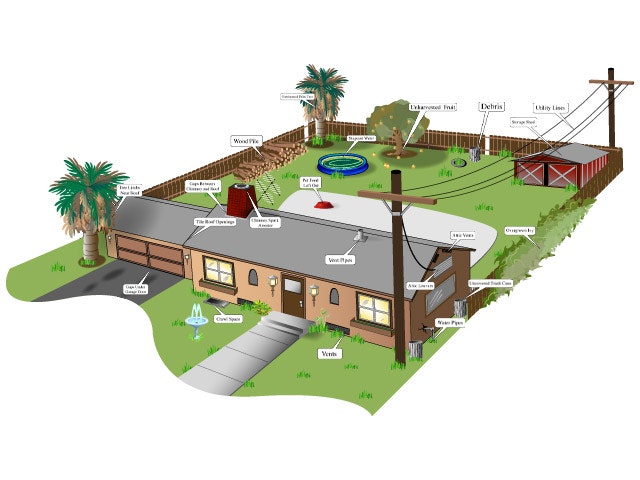Checking for roof rat activity + Rodent proofing your home
The following signs indicate roof rat activity:
- Partially eaten fruit and vegetables.
- Snail shells under bushes, on fences, or near nesting sites.
- Signs of gnawing on plastic, wood, or rubber materials.
- Rub marks caused by rats' oily fur coming in repeated contact with surfaces or objects.
- Rat droppings are usually signs of significant rat activity. The droppings are randomly scattered on a runway, feeding location, or shelter. Droppings are dark in color, spindle shaped and about 1/2 inch long.
Check for these problem areas:

What you can do
Roof rat survival and prosperity are dependent upon the existence of three basic environmental conditions:
- Abundance of food
- Available source of water
- Access to suitable harborage
Good environmental management practices are the most effective approaches to roof rat control. Sanitation and good housekeeping are the first steps in a successful rat control program. The homeowner can help control rat populations by doing the following:
- Harvest all fruit, especially oranges, avocadoes, peaches, apricots, plums, walnuts and tangerines as soon as they ripen.
- Never leave pet food outside overnight.
- Keep pet food in sealed metal containers if stored in the garage or other outbuildings.
- Keep palm trees and yucca plants well trimmed. Algerian ivy, oleander, bougainvillea, and other thickly matted plants should be periodically thinned and trimmed well away from roofs, walls, fences, utility poles, and trees. For a complete list of plants that rats nest in please click here.
- Store wood and lumber piles on racks at least 18 inches above the ground and 12 inches away from walls. Storage boxes housed in utility sheds should be stacked close together and in an orderly fashion. Clean up debris piles.
- Repair leaky faucets and eliminate any other unnecessary standing water.
When renovating the yard and/or planning new landscaping, undesirable landscape vegetation should be eliminated from the plans and replaced by vegetation types that do not afford harborage to rats. A list of alternative landscaping (e.g. ground covers) is available on this website.
